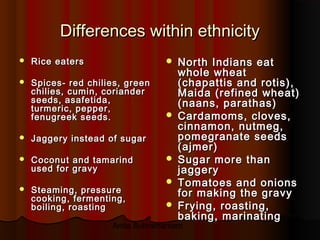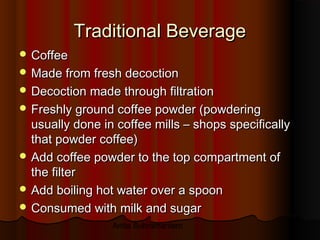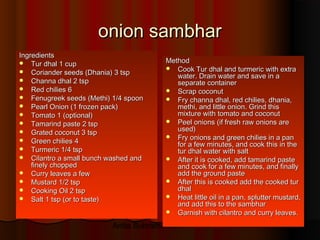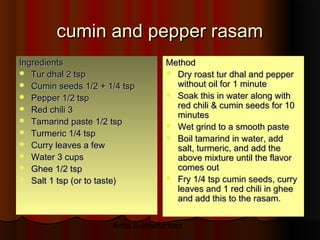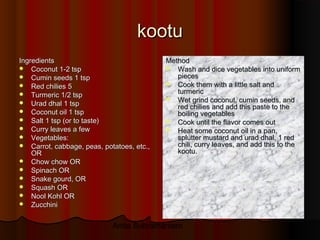Cuisine[1]
- 1. Anita Subramaniam Differences within ethnicityDifferences within ethnicity Rice eatersRice eaters Spices- red chilies, greenSpices- red chilies, green chilies, cumin, corianderchilies, cumin, coriander seeds, asafetida,seeds, asafetida, turmeric, pepper,turmeric, pepper, fenugreek seeds.fenugreek seeds. Jaggery instead of sugarJaggery instead of sugar Coconut and tamarindCoconut and tamarind used for gravyused for gravy Steaming, pressureSteaming, pressure cooking, fermenting,cooking, fermenting, boiling, roastingboiling, roasting North Indians eatNorth Indians eat whole wheatwhole wheat (chapattis and rotis),(chapattis and rotis), Maida (refined wheat)Maida (refined wheat) (naans, parathas)(naans, parathas) Cardamoms, cloves,Cardamoms, cloves, cinnamon, nutmeg,cinnamon, nutmeg, pomegranate seedspomegranate seeds (ajmer)(ajmer) Sugar more thanSugar more than jaggeryjaggery Tomatoes and onionsTomatoes and onions for making the gravyfor making the gravy Frying, roasting,Frying, roasting, baking, marinatingbaking, marinating
- 2. Anita Subramaniam Tamil Society – Clothing & FoodTamil Society – Clothing & Food Tamils live all over the world. There are Tamils in Singapore, Thailand, Madagascar, Malaysia, Sri Lanka, Canada, Australia, UK, and US.
- 3. Anita Subramaniam Introduction to Tamil CookingIntroduction to Tamil Cooking Today’s menu consists of home recipesToday’s menu consists of home recipes A few of the innumerous items using traditionalA few of the innumerous items using traditional Indian vegetables and recipesIndian vegetables and recipes Variety of items prepared for one wholesomeVariety of items prepared for one wholesome mealmeal Vary from laborious and very simpleVary from laborious and very simple Vary from spicy hot to very sweetVary from spicy hot to very sweet Healthy and unhealthy foodsHealthy and unhealthy foods Combination of several ingredients to prepareCombination of several ingredients to prepare one dishone dish Many of these items are prepared in more thanMany of these items are prepared in more than one way.. there is no single way of preparationone way.. there is no single way of preparation
- 4. Anita Subramaniam Tamil NaduTamil Nadu Food CropsFood Crops RiceRice RagiRagi BajraBajra Masoor DalMasoor Dal Moong DalMoong Dal Cash CropsCash Crops CottonCotton Sugar caneSugar cane JuteJute TeaTea CoffeeCoffee RubberRubber PlaintainPlaintain MangoMango TamarindTamarind SpicesSpices
- 5. Anita Subramaniam Rice - the main food cropRice - the main food crop India one of the largest exporters ofIndia one of the largest exporters of rice, ranking second in the world nextrice, ranking second in the world next to Thailand (Money Matters, 2004)to Thailand (Money Matters, 2004) India produces about 78 million tonnesIndia produces about 78 million tonnes of rice (rice consumption of the worldof rice (rice consumption of the world is around 408 million tonnes)is around 408 million tonnes) (Business Standard, 2003)(Business Standard, 2003) Profile of a Rice Producing Factory :Profile of a Rice Producing Factory : http://www.nazricenfoods.com/prof_nen.htmlhttp://www.nazricenfoods.com/prof_nen.html Rice production for this year is going toRice production for this year is going to be affected both in India and Chinabe affected both in India and China due to poor monsoon seasondue to poor monsoon season Rice grown in India is of differentRice grown in India is of different varietiesvarieties Kuttharisi (parboiled)Kuttharisi (parboiled) PonniPonni SambaSamba IdlyIdly Jasmine flavored riceJasmine flavored rice Rose flavored riceRose flavored rice Red riceRed rice Parboiled riceParboiled rice Rice steamed with the outer husk beforeRice steamed with the outer husk before dehuskingdehusking This enables the rice grain to retain B-This enables the rice grain to retain B- Vitamins that are usually lost during theVitamins that are usually lost during the dehusking process.dehusking process. converted rice = parboiled riceconverted rice = parboiled rice • Fast-cooking white riceFast-cooking white rice • When cooked, the grains are moreWhen cooked, the grains are more nutritious, firmer, and less clingy than whitenutritious, firmer, and less clingy than white rice grains.rice grains. Uncle Ben'sUncle Ben's is a well-knownis a well-known brand.brand. Parboiled rice is now available in otherParboiled rice is now available in other cities in India and in the US and UKcities in India and in the US and UK
- 6. Anita Subramaniam Indian Vegetables and FruitsIndian Vegetables and Fruits The common South Indian vegetablesThe common South Indian vegetables are:are: Snake gourdSnake gourd Bitter gourdBitter gourd Avaraikai (broad beans)Avaraikai (broad beans) ThondakaiThondakai DrumstickDrumstick Raw plantainsRaw plantains Banana flower (Vazha poo)Banana flower (Vazha poo) Banana stem (Vazha thandu)Banana stem (Vazha thandu) Taro root (Shepangazhangu)Taro root (Shepangazhangu) Karamani (long beans)Karamani (long beans) Small brinjalsSmall brinjals White pumpkinWhite pumpkin Different varieties of greensDifferent varieties of greens Yams (Karnakazhangu)Yams (Karnakazhangu) Kothavanrangai (cluster beans).Kothavanrangai (cluster beans). Fruits that we use are:Fruits that we use are: PapayaPapaya Jack fruitJack fruit Different varieties of mangoesDifferent varieties of mangoes SapotaSapota GuavasGuavas Different varieties of bananasDifferent varieties of bananas PerichampazhamPerichampazham PomegranatePomegranate Nagapazham.Nagapazham.
- 7. Anita Subramaniam Spices and CondimentsSpices and Condiments Coriander seedsCoriander seeds Curry leavesCurry leaves MustardMustard CilantroCilantro Red chiliesRed chilies Green chiliesGreen chilies Cumin seedsCumin seeds Fenugreek seedsFenugreek seeds (Vit. E)(Vit. E) AsafotidaAsafotida TamarindTamarind Til (Gingili seeds)Til (Gingili seeds) GingerGinger TurmericTurmeric CardamomCardamom Black pepperBlack pepper VanillaVanilla Rose essenceRose essence SaffronSaffron India is known as the 'The home of spices'. There is no other country in the world that produces as many kinds of spices as India. The climate of the country is suitable for almost all spices. According to the International Organization For Standardization (ISO); The term 'spices and condiments' applies to such natural plant or vegetable products or mixtures thereof, in whole or ground form, as are used for imparting flavor, aroma and piquancy to and for seasoning of foods". There are over 80 spices grown in different parts of the world and around 50 spices are grown in India. ROLE OF SPICES They add tang and flavor to otherwise insipid foods. Some of them also possess antioxidant properties, while others are used as preservatives in some foods like pickles and chutneys, etc. For good breath ..Chewing certain spices like cardamom, cumin, clove; improves digestion and acts as a mouth freshener. Some spices also possess strong anti-microbial and antibiotic activities. Many of them possess medicinal properties and have a profound effect on human health, since they effect many functional processes. Spices act as a stimulates to the digestive system and help digestion in many ways. Spices possibly activate the adreno-
- 8. Anita Subramaniam Cooking MethodsCooking Methods
- 9. Anita Subramaniam Traditional ToolsTraditional Tools AruvamanaiAruvamanai Ammi, AttukkalAmmi, Attukkal
- 10. Anita Subramaniam Traditions in Meal PreparationTraditions in Meal Preparation Always cooked the same dayAlways cooked the same day Cooks get to work very early inCooks get to work very early in the morning – 5 a.m.the morning – 5 a.m. Cooking only after showerCooking only after shower Must wear proper clothingMust wear proper clothing No footwearNo footwear Usually cooking done byUsually cooking done by womenwomen Although some householdsAlthough some households have male cookshave male cooks Male cooks (only) for weddingMale cooks (only) for wedding and festive occasionsand festive occasions Male and females do notMale and females do not usually cook togetherusually cook together Feet always washed beforeFeet always washed before entering the house (guests)entering the house (guests) (WHY?)(WHY?) Vegetables are washed beforeVegetables are washed before cuttingcutting Hands washed after eachHands washed after each activityactivity Must not touch old food (if any)Must not touch old food (if any) while cooking; if done, washwhile cooking; if done, wash handshands Utensils washed before useUtensils washed before use (even if washed before)(even if washed before) Cooking area cleansed afterCooking area cleansed after every meal preparationevery meal preparation Cooking area is decorated withCooking area is decorated with kolams in the nightkolams in the night
- 11. Anita Subramaniam Wet GrindingWet Grinding • Indian wet grinders use the same concept as used in hand grinding • Wet grinders are quicker than hand grinding • Wet grinders grind food for idlis and dosas better than food processors • Not useful for small quantities
- 12. Anita Subramaniam SteamingSteaming • Idlis and many items used are cooked by steaming • Healthy • No fat used • Quick
- 13. Anita Subramaniam FryingFrying Less frequent than pressure cooking, steaming orLess frequent than pressure cooking, steaming or roastingroasting Frying limited to side items such as chips likeFrying limited to side items such as chips like varuvalsvaruvals,, appalamsappalams, and, and pappadamspappadams These are usually made once a week and savedThese are usually made once a week and saved Frying also for Tiffin – afternoon snacksFrying also for Tiffin – afternoon snacks Shallow frying more common than deep fat frying (dosa,Shallow frying more common than deep fat frying (dosa, adai, appams)adai, appams) Limited to festive occasions and social get togetherLimited to festive occasions and social get together Only vegetable oil used- sunflower oil most common inOnly vegetable oil used- sunflower oil most common in India; gingili oil and coconut oil used a few decades agoIndia; gingili oil and coconut oil used a few decades ago Ghee used for seasoning and dessertsGhee used for seasoning and desserts
- 14. Anita Subramaniam Food Eating PatternsFood Eating Patterns
- 15. Anita Subramaniam Traditions in Serving FoodTraditions in Serving Food Food generally served on bananaFood generally served on banana leavesleaves Leaf is placed before the guestLeaf is placed before the guest The corner of the leaf faces right of theThe corner of the leaf faces right of the personperson Water is served first, no otherWater is served first, no other beverage is servedbeverage is served Leaf is cleaned by sprinkling water andLeaf is cleaned by sprinkling water and brushing the water with fingers (left tobrushing the water with fingers (left to right)right) Food eaten with hands –using onlyFood eaten with hands –using only fingers not the palmfingers not the palm Only right hand is used for eatingOnly right hand is used for eating Food eaten sitting on the floor on theFood eaten sitting on the floor on the full lotus position with erect backfull lotus position with erect back Seating is from left to right – no gapsSeating is from left to right – no gaps The most important person served firstThe most important person served first Sometimes the first leaf is for “puthras”Sometimes the first leaf is for “puthras” (ancestors)(ancestors) Usually in most Hindu homes, the crowUsually in most Hindu homes, the crow is served rice, dal and ghee firstis served rice, dal and ghee first outside the houseoutside the house Food served clockwiseFood served clockwise Food served from top right corner ofFood served from top right corner of the leaf to leftthe leaf to left
- 16. Anita Subramaniam Order of Serving/Eating FoodOrder of Serving/Eating Food Foods served first:Foods served first: Serving starts with a spoon ofServing starts with a spoon of “payasam”“payasam” DhalDhal Followed by salads – vegetable andFollowed by salads – vegetable and fruitfruit Vegetable dishesVegetable dishes Chutneys and pickleChutneys and pickle Vadas, laddoos and other itemsVadas, laddoos and other items First Serving of Rice:First Serving of Rice: RiceRice GheeGhee SambharSambhar AppalamAppalam Second Serving of RiceSecond Serving of Rice:: MorekozhambuMorekozhambu Second serving of all dishes that hasSecond serving of all dishes that has been consumedbeen consumed Third Serving of Rice:Third Serving of Rice: RasamRasam AppalamAppalam Main Dessert:Main Dessert: Full cup of payasamFull cup of payasam Fourth Serving of Rice:Fourth Serving of Rice: YogurtYogurt Wash Hands and chew betel leavesWash Hands and chew betel leaves Digestive:Digestive: Betel leaves with betel nut andBetel leaves with betel nut and Calcium Carbonate (lime)Calcium Carbonate (lime) Some men and women combineSome men and women combine chewing tobacco with betel leaveschewing tobacco with betel leaves
- 17. Anita Subramaniam Traditions After the MealTraditions After the Meal All food served must be consumedAll food served must be consumed Unconsumed food generally set in one side of the leafUnconsumed food generally set in one side of the leaf Leaf must not be foldedLeaf must not be folded Guest gets up and washes handsGuest gets up and washes hands Hostess always takes away the leaf after ALL the guestsHostess always takes away the leaf after ALL the guests get upget up Concept of Dharma- serving food to guests is consideredConcept of Dharma- serving food to guests is considered dharma (a generous act)dharma (a generous act) Hostess cleans the place with her handsHostess cleans the place with her hands Burping is sign of contentment of foodBurping is sign of contentment of food Guest must sit for sometime before leavingGuest must sit for sometime before leaving Betel leaf with lime and betel nuts served when the guestBetel leaf with lime and betel nuts served when the guest is seated with washed handsis seated with washed hands
- 18. Anita Subramaniam Festive OccasionsFestive Occasions Are many and celebrated withAre many and celebrated with a lot of sincerity and regularitya lot of sincerity and regularity All members participateAll members participate Certain festivals all extendedCertain festivals all extended family members attendfamily members attend Several gods and each god isSeveral gods and each god is reveredrevered Flowers, betel Leaves, betelFlowers, betel Leaves, betel nut, fruits, and, coconut arenut, fruits, and, coconut are sacred offerings for all thesacred offerings for all the festivalsfestivals Special items of food areSpecial items of food are prepared specific to eachprepared specific to each festivalfestival
- 19. Anita Subramaniam A Typical MealA Typical Meal RiceRice RasamRasam SambharSambhar KootuKootu Poriyal/CurryPoriyal/Curry YogurtYogurt GheeGhee Plain cooked DhalPlain cooked Dhal One or two of theOne or two of the below:below: ChutneyChutney PicklePickle PachadiPachadi AppalamAppalam SaladSalad Sweets on occasions only
- 20. Anita Subramaniam Traditional JuiceTraditional Juice Panagam (PAAnagam)Panagam (PAAnagam) JaggeryJaggery LimeLime GingerGinger CardamomCardamom Served before foodServed before food Only beverage served with food is water.Only beverage served with food is water.
- 21. Anita Subramaniam Traditional BeverageTraditional Beverage CoffeeCoffee Made from fresh decoctionMade from fresh decoction Decoction made through filtrationDecoction made through filtration Freshly ground coffee powder (powderingFreshly ground coffee powder (powdering usually done in coffee mills – shops specificallyusually done in coffee mills – shops specifically that powder coffee)that powder coffee) Add coffee powder to the top compartment ofAdd coffee powder to the top compartment of the filterthe filter Add boiling hot water over a spoonAdd boiling hot water over a spoon Consumed with milk and sugarConsumed with milk and sugar
- 22. Anita Subramaniam idlisidlis IngredientsIngredients Par boiled rice 3 cupsPar boiled rice 3 cups Urad dhal (Black gram-Urad dhal (Black gram- deskinned) 1 cupdeskinned) 1 cup Salt 2 tspSalt 2 tsp MethodMethod Rinse and soak rice andRinse and soak rice and urad dhal separately inurad dhal separately in water for 2 hourswater for 2 hours Grind the two separately,Grind the two separately, and mix them togetherand mix them together with saltwith salt Let it ferment overnightLet it ferment overnight Make idlis using idli traysMake idlis using idli trays Steam (no pressure).Steam (no pressure).
- 23. Anita Subramaniam onion sambharonion sambhar IngredientsIngredients Tur dhal 1 cupTur dhal 1 cup Coriander seeds (Dhania) 3 tspCoriander seeds (Dhania) 3 tsp Channa dhal 2 tspChanna dhal 2 tsp Red chilies 6Red chilies 6 Fenugreek seeds (Methi) 1/4 spoonFenugreek seeds (Methi) 1/4 spoon Pearl Onion (1 frozen pack)Pearl Onion (1 frozen pack) Tomato 1 (optional)Tomato 1 (optional) Tamarind paste 2 tspTamarind paste 2 tsp Grated coconut 3 tspGrated coconut 3 tsp Green chilies 4Green chilies 4 Turmeric 1/4 tspTurmeric 1/4 tsp Cilantro a small bunch washed andCilantro a small bunch washed and finely choppedfinely chopped Curry leaves a fewCurry leaves a few Mustard 1/2 tspMustard 1/2 tsp Cooking Oil 2 tspCooking Oil 2 tsp Salt 1 tsp (or to taste)Salt 1 tsp (or to taste) MethodMethod Cook Tur dhal and turmeric with extraCook Tur dhal and turmeric with extra water. Drain water and save in awater. Drain water and save in a separate containerseparate container Scrap coconutScrap coconut Fry channa dhal, red chilies, dhania,Fry channa dhal, red chilies, dhania, methi, and little onion. Grind thismethi, and little onion. Grind this mixture with tomato and coconutmixture with tomato and coconut Peel onions (if fresh raw onions arePeel onions (if fresh raw onions are used)used) Fry onions and green chilies in a panFry onions and green chilies in a pan for a few minutes, and cook this in thefor a few minutes, and cook this in the tur dhal water with salttur dhal water with salt After it is cooked, add tamarind pasteAfter it is cooked, add tamarind paste and cook for a few minutes, and finallyand cook for a few minutes, and finally add the ground pasteadd the ground paste After this is cooked add the cooked turAfter this is cooked add the cooked tur dhaldhal Heat little oil in a pan, splutter mustard,Heat little oil in a pan, splutter mustard, and add this to the sambharand add this to the sambhar Garnish with cilantro and curry leaves.Garnish with cilantro and curry leaves.
- 24. Anita Subramaniam cumin and pepper rasamcumin and pepper rasam IngredientsIngredients Tur dhal 2 tspTur dhal 2 tsp Cumin seeds 1/2 + 1/4 tspCumin seeds 1/2 + 1/4 tsp Pepper 1/2 tspPepper 1/2 tsp Red chili 3Red chili 3 Tamarind paste 1/2 tspTamarind paste 1/2 tsp Turmeric 1/4 tspTurmeric 1/4 tsp Curry leaves a fewCurry leaves a few Water 3 cupsWater 3 cups Ghee 1/2 tspGhee 1/2 tsp Salt 1 tsp (or to taste)Salt 1 tsp (or to taste) MethodMethod Dry roast tur dhal and pepperDry roast tur dhal and pepper without oil for 1 minutewithout oil for 1 minute Soak this in water along withSoak this in water along with red chili & cumin seeds for 10red chili & cumin seeds for 10 minutesminutes Wet grind to a smooth pasteWet grind to a smooth paste Boil tamarind in water, addBoil tamarind in water, add salt, turmeric, and add thesalt, turmeric, and add the above mixture until the flavorabove mixture until the flavor comes outcomes out Fry 1/4 tsp cumin seeds, curryFry 1/4 tsp cumin seeds, curry leaves and 1 red chili in gheeleaves and 1 red chili in ghee and add this to the rasam.and add this to the rasam.
- 25. Anita Subramaniam moor kozhambumoor kozhambu IngredientsIngredients Cumin seeds 1 tspCumin seeds 1 tsp Red chilies 4Red chilies 4 Green chilies 2Green chilies 2 Rice flour 1/2 tspRice flour 1/2 tsp Asafetida (hing) a small pinchAsafetida (hing) a small pinch Coconut 4 tspCoconut 4 tsp Coconut oil 1 tsp (optional)Coconut oil 1 tsp (optional) Sour cream or butter milk 4 cupsSour cream or butter milk 4 cups Turmeric 1/4 tspTurmeric 1/4 tsp Mustard 1/4 tspMustard 1/4 tsp Salt 1 tsp (or to taste)Salt 1 tsp (or to taste) Curry leaves a fewCurry leaves a few Cilantro a small bunch washedCilantro a small bunch washed and finely choppedand finely chopped Vegetables - White pumpkin orVegetables - White pumpkin or okra, or zucchini or squashokra, or zucchini or squash MethodMethod Cut vegetable into big pieces andCut vegetable into big pieces and cook in water. If using okra, needcook in water. If using okra, need not cook but have to fry a littlenot cook but have to fry a little Grind cumin, rice flour, red chilies,Grind cumin, rice flour, red chilies, with coconut and little salt andwith coconut and little salt and butter milkbutter milk Heat some coconut/vegetable oil,Heat some coconut/vegetable oil, splutter mustard seedssplutter mustard seeds Add curry leaves, little hing, salt,Add curry leaves, little hing, salt, turmeric and the vegetables, andturmeric and the vegetables, and fry this for a few minutesfry this for a few minutes Now add the ground paste and theNow add the ground paste and the remaining butter milk to the aboveremaining butter milk to the above and bring this to a boil on a lowand bring this to a boil on a low flameflame Simmer for a few minutesSimmer for a few minutes Garnish with cilantro.Garnish with cilantro.
- 26. Anita Subramaniam kootukootu IngredientsIngredients Coconut 1-2 tspCoconut 1-2 tsp Cumin seeds 1 tspCumin seeds 1 tsp Red chilies 5Red chilies 5 Turmeric 1/2 tspTurmeric 1/2 tsp Urad dhal 1 tspUrad dhal 1 tsp Coconut oil 1 tspCoconut oil 1 tsp Salt 1 tsp (or to taste)Salt 1 tsp (or to taste) Curry leaves a fewCurry leaves a few Vegetables:Vegetables: Carrot, cabbage, peas, potatoes, etc.,Carrot, cabbage, peas, potatoes, etc., OROR Chow chow ORChow chow OR Spinach ORSpinach OR Snake gourd, ORSnake gourd, OR Squash ORSquash OR Nool Kohl ORNool Kohl OR ZucchiniZucchini MethodMethod Wash and dice vegetables into uniformWash and dice vegetables into uniform piecespieces Cook them with a little salt andCook them with a little salt and turmericturmeric Wet grind coconut, cumin seeds, andWet grind coconut, cumin seeds, and red chilies and add this paste to thered chilies and add this paste to the boiling vegetablesboiling vegetables Cook until the flavor comes outCook until the flavor comes out Heat some coconut oil in a pan,Heat some coconut oil in a pan, splutter mustard and urad dhal, 1 redsplutter mustard and urad dhal, 1 red chili, curry leaves, and add this to thechili, curry leaves, and add this to the kootu.kootu.
- 27. Anita Subramaniam ChutneyChutney Coconut chutneyCoconut chutney IngredientsIngredients Coconut 1/2 cup gratedCoconut 1/2 cup grated Roasted channa dal (Pottu Kadalai) 3Roasted channa dal (Pottu Kadalai) 3 tsptsp Green chilies 2Green chilies 2 Salt 1/2 tspSalt 1/2 tsp MethodMethod Grind all the above ingredients.Grind all the above ingredients. Cilantro chutneyCilantro chutney IngredientsIngredients Urad dhal 4 tspUrad dhal 4 tsp Channa dhal 2 tspChanna dhal 2 tsp Red chilies 2Red chilies 2 Green chilies 2Green chilies 2 Cilantro 1 bunchCilantro 1 bunch Hing 1/4 tspHing 1/4 tsp Tamarind paste 1/4 tspTamarind paste 1/4 tsp Salt 1/2 tspSalt 1/2 tsp Oil 2 tspOil 2 tsp MethodMethod Fry urad dhal, channa dhal, red chilies,Fry urad dhal, channa dhal, red chilies, green chilies, and hing in oil.green chilies, and hing in oil. Wet grind the above with choppedWet grind the above with chopped cilantro, salt, and tamarind paste.cilantro, salt, and tamarind paste.
- 28. Anita Subramaniam tomato pachaditomato pachadi IngredientsIngredients Tomato 1 big and a few smallTomato 1 big and a few small ones washed and choppedones washed and chopped Yogurt 2 cupsYogurt 2 cups Curry leaves a fewCurry leaves a few Mustard 1/4 tspMustard 1/4 tsp Asafetida (hing) a small pinchAsafetida (hing) a small pinch Green chilies chopped 2-3Green chilies chopped 2-3 Cooking Oil 1.5 tspCooking Oil 1.5 tsp Cilantro a small bunch washedCilantro a small bunch washed and finely choppedand finely chopped Salt 1/2 tsp (or to taste)Salt 1/2 tsp (or to taste) MethodMethod Splutter mustard, and addSplutter mustard, and add hing, curry leaves, greenhing, curry leaves, green chilieschilies Add tomato in oil and fry for 5-Add tomato in oil and fry for 5- 10 minutes10 minutes Add salt, and mix this withAdd salt, and mix this with yogurtyogurt Garnish with chopped cilantro.Garnish with chopped cilantro.

